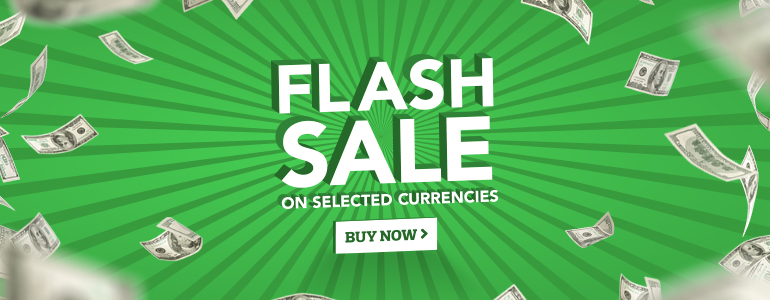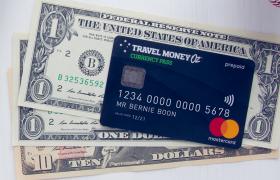Newsflash: today is the last day of Click Frenzy! You have until midnight tonight to get more bang for your travel money buck and make the most of our frenzy rates. You don’t even need to add a code either as the bonus is automatically applied to your purchase. Extra cash for your holiday seems like a pretty good way to start the weekend if you ask me.
In other, less frenzical, news, the Aussie dollar has had an interesting week. It is still feeling the impact of trade decisions, domestic data and a looming global economic slowdown. After peaking against the USD on Wednesday, it saw a slight decrease as the week came to a close. With this in mind, one Aussie Dollar will currently buy you:
0.6630 US dollars
69.626 Japanese yen
0.5926 Euros
0.5347 Great British pound
0.8550 Canadian dollars
1.0337 New Zealand dollars
0.8948 Singapore dollars
Don’t forget to add Rate Guard to your currency exchange in store! It’s free and will protect you against rate movements. If your rate improves within 14 days of purchase, we will refund you the difference*.
USD News
The USD marked some gains against several currencies despite warnings at the start of the week that the US economy is heading towards a recession. Perhaps it has adopted the ‘everything is fine’ attitude of their fearless leader.
In regards to US interest rates, a growing number of Federal Reserve presidents have said they are reluctant to cut interest rates further in the coming months. Many believe the economy is sitting quite neutral and would like it to remain that way for a while. Currently, there is a split in opinion among Fed board members, so their next meeting and corresponding commentary will prove interesting.
GBP News
Unlike the Aussie dollar, the pound saw a lift against the USD overnight which, in turn, cause it to strengthen against the AUD. Bad news for us, but I think we can give the Poms a break considering all of the Brexit shenanigans they have had to endure.
On the Brexit front, UK Prime Minister Boris Johnson flew to France and met with President Emmanuel Macron. Johnson set forth some requests, or rather some demands to negotiate a brand new Brexit deal before the October 31 deadline. This deal would, Boris hopes, include removing the Northern Ireland backstop. While German PM Angela Merkel has said it could be possible to renegotiate the backstop before October 31, Macron declined Johnson’s demands, stating it would be hard to draw up a deal significantly different to the one currently in place.
Despite Merkel’s optimism, at this stage, the UK is still headed for a hard-Brexit (a.k.a leaving the EU with a no-deal) on October 31.
Domestic News
The end of this week saw three different positive news stories for the Australian economy. We’ve broken them down below.
1. Sydney and Melbourne auction clearance rates at two-year high
Currently, the percentage of successful auctions each week in Sydney and Melbourne are at their highest level since 2017. This is excellent news; however, we must consider it alongside the fact that there are fewer properties listed on the market than usual.
The culmination of these factors has made economists question the trajectory of house prices as we head into Spring. Generally, Spring months see an increase in the number of people taking their houses to auction. Economists are concerned the increased supply of properties on the market will weaken prices and spell more bad news for the economy.
While their concerns are valid, a recent analysis by Domain has found little correlation between demand and the number of properties for sale. Should demand hold steady during the Spring period it could very well provide a much-needed boost to house prices and the broader Australian economy.
2. Increase in used car sales
Online car ad site Carsales.com has announced its revenue increased by 11% in the last 12 months. Better yet, they expect this growth will continue as Aussie’s reap the benefits of cuts income tax and interest rates. The less tax and interest people have to pay, the more money they have to spend. This is good news for the economy; however, it is also worth noting that sales of new cars are down by more than 7% on last years figures.
Generally, cars are the next big-ticket item after house purchases, so car sales are a reliable indicator of overall consumer sentiment about the state of the economy. The more people are spending, the better it is for businesses and the economy. While the interest rate cuts aren’t good for the Aussie Dollar in the short term, it is definitely in our best interest to improve the state of the overall economy.
3. Economic growth forecasts have moved into positive territory
The Westpac-Melbourne Institute Leading Index indicates how the Aussie economy should track over the next three to nine months. After ten months in the negative, the indicator finally moved into positive territory at 0.05% in July.
This result was given a leg up by July’s stock market gains, strong commodity prices and better than expected dwelling approval numbers.
Don’t get your hopes up too much, though, as the start of August saw a considerable share market sell-off as well as continued weakness in the global economy. Plus, the number of people in mortgage arrears (more than 90 days behind their payments) has grown to 0.9%. This is rough, as decreasing house prices have resulted in a lot of people owing the bank more than their house is worth.
Further to this, on Thursday the Commonwealth Bank’s Australian Composite Purchasing Managers Index (PMI) report showed a fall in August to 49.5%. This is a sign that business activity is shrinking, particularly in the services sector. The result weighed heavily on the value of the Aussie dollar as it drove a risk-averse attitude in the markets. The AUD is considered to be a risky investment, and it thrives during ‘risk-on’ periods. When markets are risk-averse, they will abandon the AUD in favour of more secure investments.
The Reserve Bank of Australia meets in two weeks, where many expect they will take all of this into account and cut interest rates further. A cut will hopefully see a decrease in the unemployment rate and encourage more people to spend money to stimulate the economy.
All in all, this week was a bit of a mixed bag for the Aussie dollar and global financial markets. All I know is that the bonza Clicky Frenzy rates won’t stick around for long.
This blog is provided for information only and does not take into consideration your objectives, financial situation or needs. You should consider whether the information and suggestions contained in any blog entry are appropriate for you, having regard to your own objectives, financial situation and needs. While we take reasonable care in providing the blog, we give no warranties or representations that it is complete or accurate, or is appropriate for you. We are not liable for any loss caused, whether due to negligence or otherwise, arising from the use of, or reliance on, the information and/or suggestions contained in this blog. All rates are quoted from the Travel Money Oz website and are valid as of August 23 2019. Terms and conditions apply to Rate Guard. See https://www.travelmoneyoz.com/rate-guard for more information.














